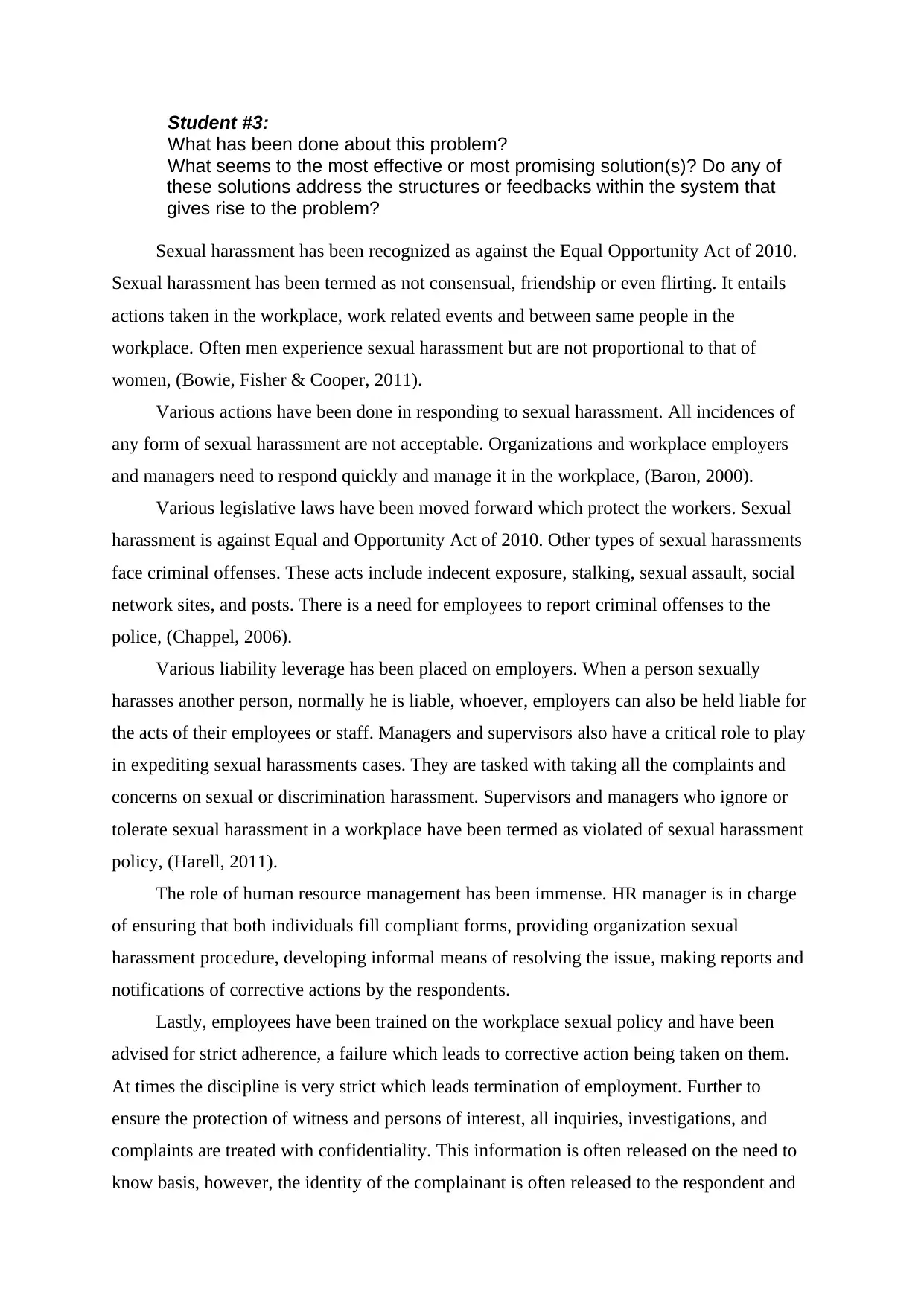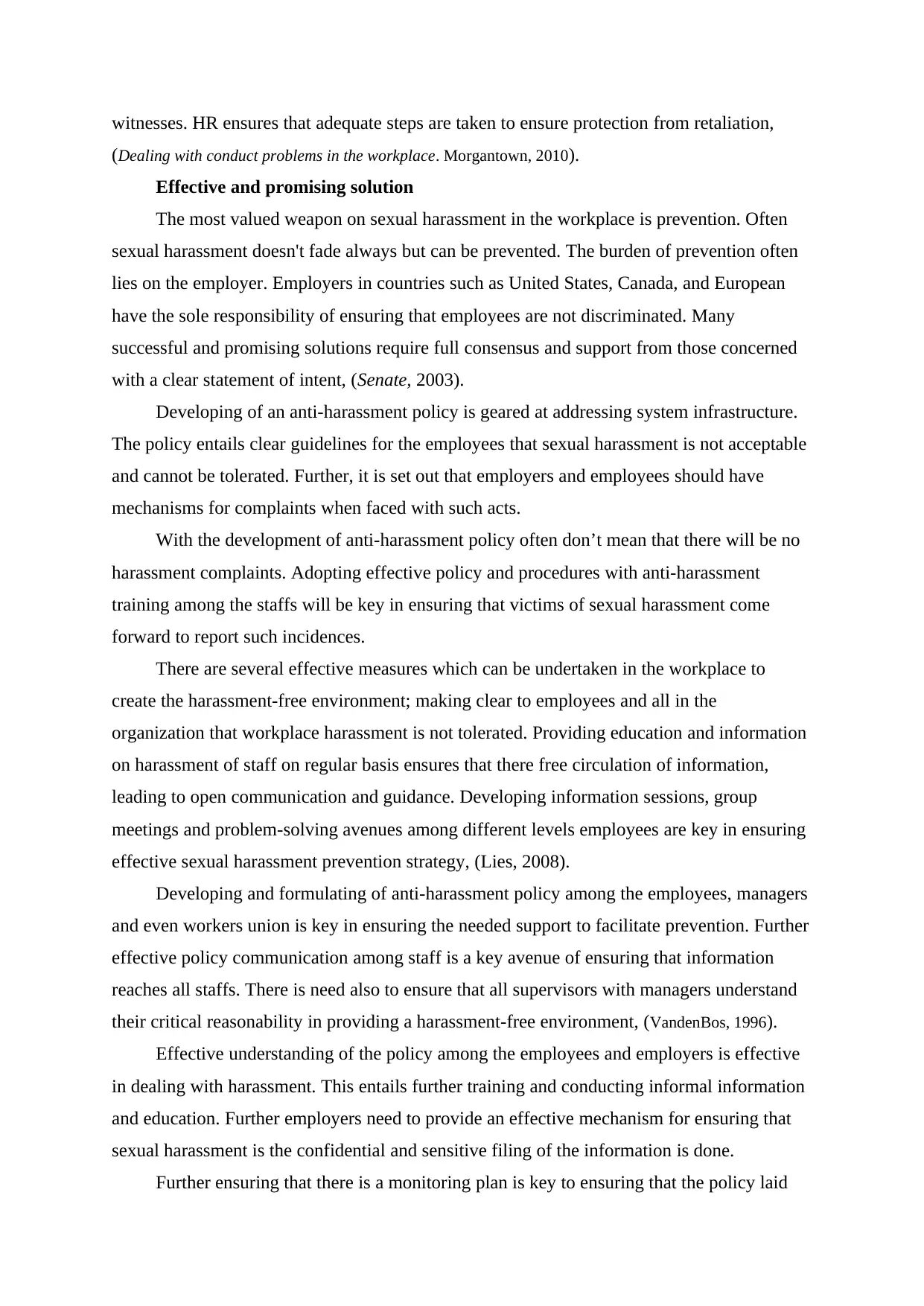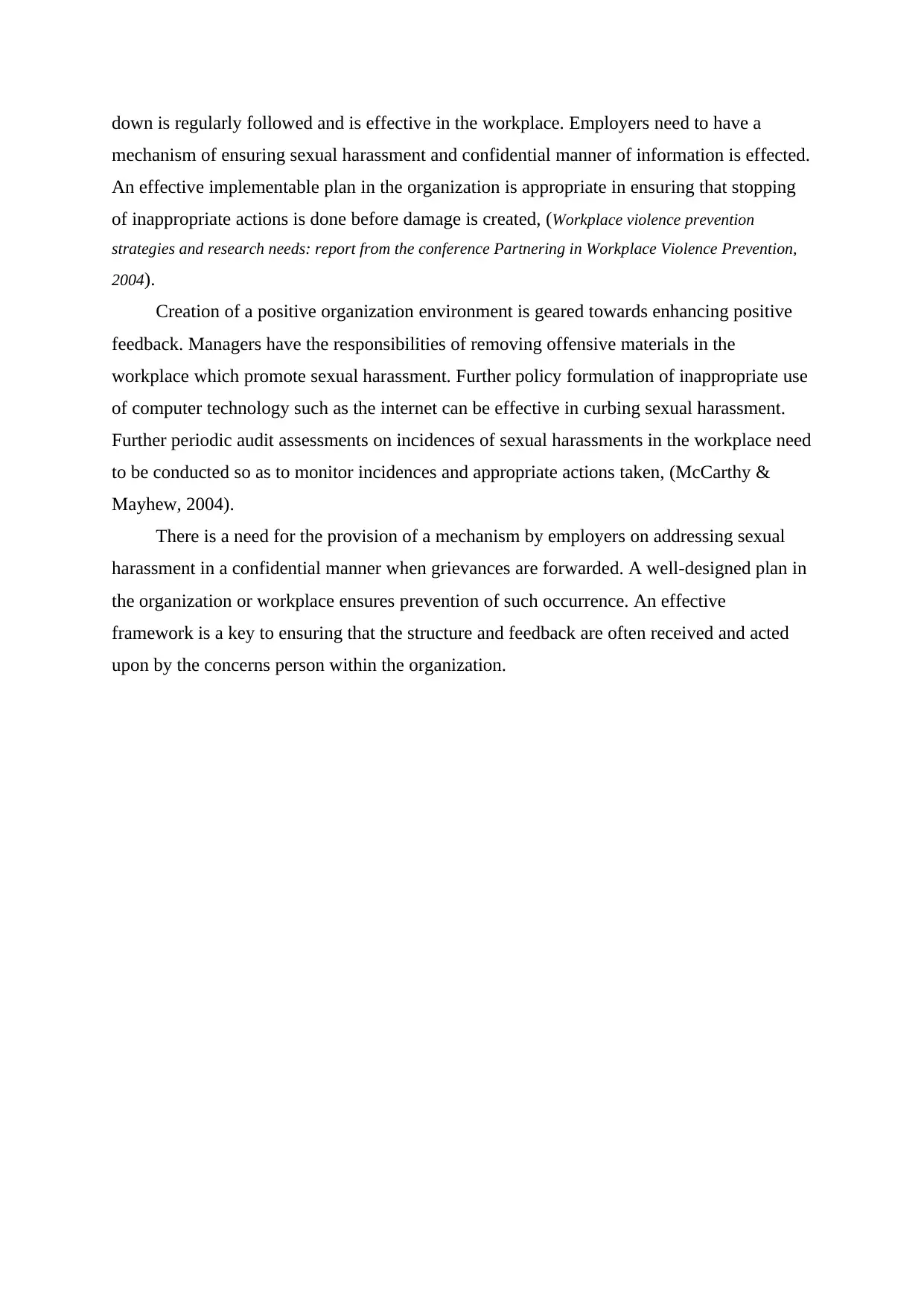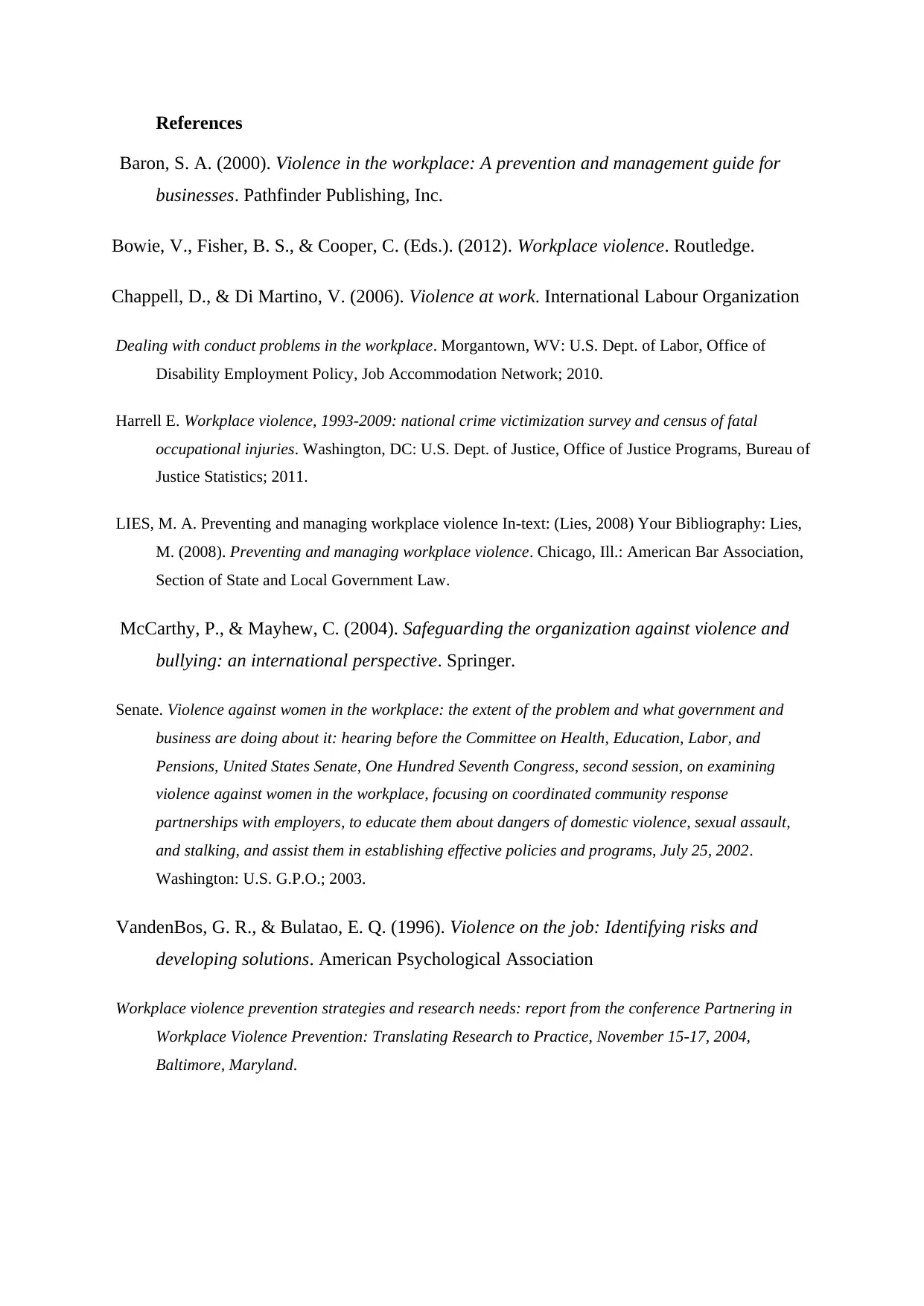Strategies and Solutions for Preventing Workplace Sexual Harassment
VerifiedAdded on 2021/04/17
|4
|1533
|71
Report
AI Summary
This report examines the issue of sexual harassment in the workplace, highlighting its legal implications under the Equal Opportunity Act of 2010 and other criminal offenses. It explores various responses, including legislative laws, employer liability, and the crucial roles of managers, supervisors, and human resource management. The report emphasizes the importance of prevention, with a focus on developing anti-harassment policies, providing employee training, and creating a positive organizational environment. Effective solutions include clear communication, information sessions, and confidential reporting mechanisms. The report stresses the need for employers to establish confidential processes, monitor policy effectiveness, and address inappropriate actions before they escalate. References to relevant literature support the findings, underscoring the importance of a proactive approach to prevent and manage workplace sexual harassment.

Student #3:
What has been done about this problem?
What seems to the most effective or most promising solution(s)? Do any of
these solutions address the structures or feedbacks within the system that
gives rise to the problem?
Sexual harassment has been recognized as against the Equal Opportunity Act of 2010.
Sexual harassment has been termed as not consensual, friendship or even flirting. It entails
actions taken in the workplace, work related events and between same people in the
workplace. Often men experience sexual harassment but are not proportional to that of
women, (Bowie, Fisher & Cooper, 2011).
Various actions have been done in responding to sexual harassment. All incidences of
any form of sexual harassment are not acceptable. Organizations and workplace employers
and managers need to respond quickly and manage it in the workplace, (Baron, 2000).
Various legislative laws have been moved forward which protect the workers. Sexual
harassment is against Equal and Opportunity Act of 2010. Other types of sexual harassments
face criminal offenses. These acts include indecent exposure, stalking, sexual assault, social
network sites, and posts. There is a need for employees to report criminal offenses to the
police, (Chappel, 2006).
Various liability leverage has been placed on employers. When a person sexually
harasses another person, normally he is liable, whoever, employers can also be held liable for
the acts of their employees or staff. Managers and supervisors also have a critical role to play
in expediting sexual harassments cases. They are tasked with taking all the complaints and
concerns on sexual or discrimination harassment. Supervisors and managers who ignore or
tolerate sexual harassment in a workplace have been termed as violated of sexual harassment
policy, (Harell, 2011).
The role of human resource management has been immense. HR manager is in charge
of ensuring that both individuals fill compliant forms, providing organization sexual
harassment procedure, developing informal means of resolving the issue, making reports and
notifications of corrective actions by the respondents.
Lastly, employees have been trained on the workplace sexual policy and have been
advised for strict adherence, a failure which leads to corrective action being taken on them.
At times the discipline is very strict which leads termination of employment. Further to
ensure the protection of witness and persons of interest, all inquiries, investigations, and
complaints are treated with confidentiality. This information is often released on the need to
know basis, however, the identity of the complainant is often released to the respondent and
What has been done about this problem?
What seems to the most effective or most promising solution(s)? Do any of
these solutions address the structures or feedbacks within the system that
gives rise to the problem?
Sexual harassment has been recognized as against the Equal Opportunity Act of 2010.
Sexual harassment has been termed as not consensual, friendship or even flirting. It entails
actions taken in the workplace, work related events and between same people in the
workplace. Often men experience sexual harassment but are not proportional to that of
women, (Bowie, Fisher & Cooper, 2011).
Various actions have been done in responding to sexual harassment. All incidences of
any form of sexual harassment are not acceptable. Organizations and workplace employers
and managers need to respond quickly and manage it in the workplace, (Baron, 2000).
Various legislative laws have been moved forward which protect the workers. Sexual
harassment is against Equal and Opportunity Act of 2010. Other types of sexual harassments
face criminal offenses. These acts include indecent exposure, stalking, sexual assault, social
network sites, and posts. There is a need for employees to report criminal offenses to the
police, (Chappel, 2006).
Various liability leverage has been placed on employers. When a person sexually
harasses another person, normally he is liable, whoever, employers can also be held liable for
the acts of their employees or staff. Managers and supervisors also have a critical role to play
in expediting sexual harassments cases. They are tasked with taking all the complaints and
concerns on sexual or discrimination harassment. Supervisors and managers who ignore or
tolerate sexual harassment in a workplace have been termed as violated of sexual harassment
policy, (Harell, 2011).
The role of human resource management has been immense. HR manager is in charge
of ensuring that both individuals fill compliant forms, providing organization sexual
harassment procedure, developing informal means of resolving the issue, making reports and
notifications of corrective actions by the respondents.
Lastly, employees have been trained on the workplace sexual policy and have been
advised for strict adherence, a failure which leads to corrective action being taken on them.
At times the discipline is very strict which leads termination of employment. Further to
ensure the protection of witness and persons of interest, all inquiries, investigations, and
complaints are treated with confidentiality. This information is often released on the need to
know basis, however, the identity of the complainant is often released to the respondent and
Paraphrase This Document
Need a fresh take? Get an instant paraphrase of this document with our AI Paraphraser

witnesses. HR ensures that adequate steps are taken to ensure protection from retaliation,
(Dealing with conduct problems in the workplace. Morgantown, 2010).
Effective and promising solution
The most valued weapon on sexual harassment in the workplace is prevention. Often
sexual harassment doesn't fade always but can be prevented. The burden of prevention often
lies on the employer. Employers in countries such as United States, Canada, and European
have the sole responsibility of ensuring that employees are not discriminated. Many
successful and promising solutions require full consensus and support from those concerned
with a clear statement of intent, (Senate, 2003).
Developing of an anti-harassment policy is geared at addressing system infrastructure.
The policy entails clear guidelines for the employees that sexual harassment is not acceptable
and cannot be tolerated. Further, it is set out that employers and employees should have
mechanisms for complaints when faced with such acts.
With the development of anti-harassment policy often don’t mean that there will be no
harassment complaints. Adopting effective policy and procedures with anti-harassment
training among the staffs will be key in ensuring that victims of sexual harassment come
forward to report such incidences.
There are several effective measures which can be undertaken in the workplace to
create the harassment-free environment; making clear to employees and all in the
organization that workplace harassment is not tolerated. Providing education and information
on harassment of staff on regular basis ensures that there free circulation of information,
leading to open communication and guidance. Developing information sessions, group
meetings and problem-solving avenues among different levels employees are key in ensuring
effective sexual harassment prevention strategy, (Lies, 2008).
Developing and formulating of anti-harassment policy among the employees, managers
and even workers union is key in ensuring the needed support to facilitate prevention. Further
effective policy communication among staff is a key avenue of ensuring that information
reaches all staffs. There is need also to ensure that all supervisors with managers understand
their critical reasonability in providing a harassment-free environment, (VandenBos, 1996).
Effective understanding of the policy among the employees and employers is effective
in dealing with harassment. This entails further training and conducting informal information
and education. Further employers need to provide an effective mechanism for ensuring that
sexual harassment is the confidential and sensitive filing of the information is done.
Further ensuring that there is a monitoring plan is key to ensuring that the policy laid
(Dealing with conduct problems in the workplace. Morgantown, 2010).
Effective and promising solution
The most valued weapon on sexual harassment in the workplace is prevention. Often
sexual harassment doesn't fade always but can be prevented. The burden of prevention often
lies on the employer. Employers in countries such as United States, Canada, and European
have the sole responsibility of ensuring that employees are not discriminated. Many
successful and promising solutions require full consensus and support from those concerned
with a clear statement of intent, (Senate, 2003).
Developing of an anti-harassment policy is geared at addressing system infrastructure.
The policy entails clear guidelines for the employees that sexual harassment is not acceptable
and cannot be tolerated. Further, it is set out that employers and employees should have
mechanisms for complaints when faced with such acts.
With the development of anti-harassment policy often don’t mean that there will be no
harassment complaints. Adopting effective policy and procedures with anti-harassment
training among the staffs will be key in ensuring that victims of sexual harassment come
forward to report such incidences.
There are several effective measures which can be undertaken in the workplace to
create the harassment-free environment; making clear to employees and all in the
organization that workplace harassment is not tolerated. Providing education and information
on harassment of staff on regular basis ensures that there free circulation of information,
leading to open communication and guidance. Developing information sessions, group
meetings and problem-solving avenues among different levels employees are key in ensuring
effective sexual harassment prevention strategy, (Lies, 2008).
Developing and formulating of anti-harassment policy among the employees, managers
and even workers union is key in ensuring the needed support to facilitate prevention. Further
effective policy communication among staff is a key avenue of ensuring that information
reaches all staffs. There is need also to ensure that all supervisors with managers understand
their critical reasonability in providing a harassment-free environment, (VandenBos, 1996).
Effective understanding of the policy among the employees and employers is effective
in dealing with harassment. This entails further training and conducting informal information
and education. Further employers need to provide an effective mechanism for ensuring that
sexual harassment is the confidential and sensitive filing of the information is done.
Further ensuring that there is a monitoring plan is key to ensuring that the policy laid

down is regularly followed and is effective in the workplace. Employers need to have a
mechanism of ensuring sexual harassment and confidential manner of information is effected.
An effective implementable plan in the organization is appropriate in ensuring that stopping
of inappropriate actions is done before damage is created, (Workplace violence prevention
strategies and research needs: report from the conference Partnering in Workplace Violence Prevention,
2004).
Creation of a positive organization environment is geared towards enhancing positive
feedback. Managers have the responsibilities of removing offensive materials in the
workplace which promote sexual harassment. Further policy formulation of inappropriate use
of computer technology such as the internet can be effective in curbing sexual harassment.
Further periodic audit assessments on incidences of sexual harassments in the workplace need
to be conducted so as to monitor incidences and appropriate actions taken, (McCarthy &
Mayhew, 2004).
There is a need for the provision of a mechanism by employers on addressing sexual
harassment in a confidential manner when grievances are forwarded. A well-designed plan in
the organization or workplace ensures prevention of such occurrence. An effective
framework is a key to ensuring that the structure and feedback are often received and acted
upon by the concerns person within the organization.
mechanism of ensuring sexual harassment and confidential manner of information is effected.
An effective implementable plan in the organization is appropriate in ensuring that stopping
of inappropriate actions is done before damage is created, (Workplace violence prevention
strategies and research needs: report from the conference Partnering in Workplace Violence Prevention,
2004).
Creation of a positive organization environment is geared towards enhancing positive
feedback. Managers have the responsibilities of removing offensive materials in the
workplace which promote sexual harassment. Further policy formulation of inappropriate use
of computer technology such as the internet can be effective in curbing sexual harassment.
Further periodic audit assessments on incidences of sexual harassments in the workplace need
to be conducted so as to monitor incidences and appropriate actions taken, (McCarthy &
Mayhew, 2004).
There is a need for the provision of a mechanism by employers on addressing sexual
harassment in a confidential manner when grievances are forwarded. A well-designed plan in
the organization or workplace ensures prevention of such occurrence. An effective
framework is a key to ensuring that the structure and feedback are often received and acted
upon by the concerns person within the organization.
⊘ This is a preview!⊘
Do you want full access?
Subscribe today to unlock all pages.

Trusted by 1+ million students worldwide

References
Baron, S. A. (2000). Violence in the workplace: A prevention and management guide for
businesses. Pathfinder Publishing, Inc.
Bowie, V., Fisher, B. S., & Cooper, C. (Eds.). (2012). Workplace violence. Routledge.
Chappell, D., & Di Martino, V. (2006). Violence at work. International Labour Organization
Dealing with conduct problems in the workplace. Morgantown, WV: U.S. Dept. of Labor, Office of
Disability Employment Policy, Job Accommodation Network; 2010.
Harrell E. Workplace violence, 1993-2009: national crime victimization survey and census of fatal
occupational injuries. Washington, DC: U.S. Dept. of Justice, Office of Justice Programs, Bureau of
Justice Statistics; 2011.
LIES, M. A. Preventing and managing workplace violence In-text: (Lies, 2008) Your Bibliography: Lies,
M. (2008). Preventing and managing workplace violence. Chicago, Ill.: American Bar Association,
Section of State and Local Government Law.
McCarthy, P., & Mayhew, C. (2004). Safeguarding the organization against violence and
bullying: an international perspective. Springer.
Senate. Violence against women in the workplace: the extent of the problem and what government and
business are doing about it: hearing before the Committee on Health, Education, Labor, and
Pensions, United States Senate, One Hundred Seventh Congress, second session, on examining
violence against women in the workplace, focusing on coordinated community response
partnerships with employers, to educate them about dangers of domestic violence, sexual assault,
and stalking, and assist them in establishing effective policies and programs, July 25, 2002.
Washington: U.S. G.P.O.; 2003.
VandenBos, G. R., & Bulatao, E. Q. (1996). Violence on the job: Identifying risks and
developing solutions. American Psychological Association
Workplace violence prevention strategies and research needs: report from the conference Partnering in
Workplace Violence Prevention: Translating Research to Practice, November 15-17, 2004,
Baltimore, Maryland.
Baron, S. A. (2000). Violence in the workplace: A prevention and management guide for
businesses. Pathfinder Publishing, Inc.
Bowie, V., Fisher, B. S., & Cooper, C. (Eds.). (2012). Workplace violence. Routledge.
Chappell, D., & Di Martino, V. (2006). Violence at work. International Labour Organization
Dealing with conduct problems in the workplace. Morgantown, WV: U.S. Dept. of Labor, Office of
Disability Employment Policy, Job Accommodation Network; 2010.
Harrell E. Workplace violence, 1993-2009: national crime victimization survey and census of fatal
occupational injuries. Washington, DC: U.S. Dept. of Justice, Office of Justice Programs, Bureau of
Justice Statistics; 2011.
LIES, M. A. Preventing and managing workplace violence In-text: (Lies, 2008) Your Bibliography: Lies,
M. (2008). Preventing and managing workplace violence. Chicago, Ill.: American Bar Association,
Section of State and Local Government Law.
McCarthy, P., & Mayhew, C. (2004). Safeguarding the organization against violence and
bullying: an international perspective. Springer.
Senate. Violence against women in the workplace: the extent of the problem and what government and
business are doing about it: hearing before the Committee on Health, Education, Labor, and
Pensions, United States Senate, One Hundred Seventh Congress, second session, on examining
violence against women in the workplace, focusing on coordinated community response
partnerships with employers, to educate them about dangers of domestic violence, sexual assault,
and stalking, and assist them in establishing effective policies and programs, July 25, 2002.
Washington: U.S. G.P.O.; 2003.
VandenBos, G. R., & Bulatao, E. Q. (1996). Violence on the job: Identifying risks and
developing solutions. American Psychological Association
Workplace violence prevention strategies and research needs: report from the conference Partnering in
Workplace Violence Prevention: Translating Research to Practice, November 15-17, 2004,
Baltimore, Maryland.
1 out of 4
Related Documents
Your All-in-One AI-Powered Toolkit for Academic Success.
+13062052269
info@desklib.com
Available 24*7 on WhatsApp / Email
![[object Object]](/_next/static/media/star-bottom.7253800d.svg)
Unlock your academic potential
Copyright © 2020–2025 A2Z Services. All Rights Reserved. Developed and managed by ZUCOL.




